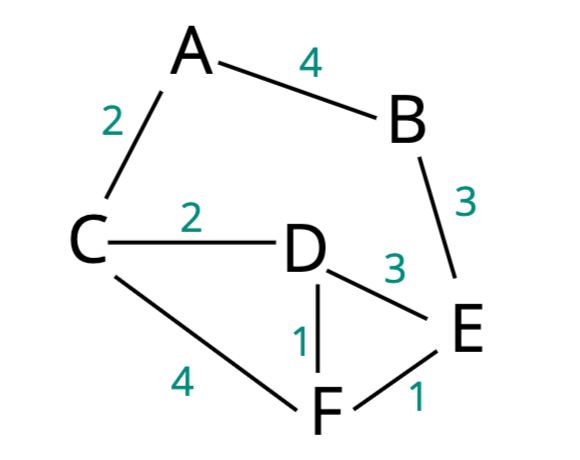Dijkstra's Algorithm
此演算法是由一位叫 Edsger Dijkstra 的荷蘭工程師所發明,他在電腦科學領域貢獻了許多奠定目前網際網路、電腦科學與數位服務等等的基礎。
在學習 Dijkstra's Algorithm 需前理解資料結構的 Priority Queue 與 Graph 。
而 Dijkstra's Algorithm 正是用他的名字來命名,此演算法是用於找出在 Graph 中兩個節點之間的最短路徑。
由於找最短路徑的應用場景中,每兩個節點之間的距離可能都會不一樣,所以我們需要先實作一個 Weighted Graph 。
Weighted Graph
class WeightedGraph {
constructor() {
this.adjacencyList = {}
}
addVertex(vertex) {
if (!this.adjacencyList[vertex]) this.adjacencyList[vertex] = []
}
addEdge(vertex1, vertex2, weight) {
if (this.adjacencyList[vertex1] && this.adjacencyList[vertex2]) {
this.adjacencyList[vertex1].push({node: vertex2, weight})
this.adjacencyList[vertex2].push({node: vertex1, weight})
}
}
}
剩餘的部分可參考 Graph 章節。
Pseudo Code

以上圖為例子,找尋從 A 到 E 的最短距離。
我們需要定義幾個變數:
distances- 記錄從初始節點到各個節點所需的距離previous- 紀錄到各個節點時,上個節點是哪個
一開始初始化變數時,我們將 distances 的 A 節點紀錄為 0 (從 A 到 A 的距離當然為零),其他的節點紀錄為 Infinity。
previous 則是各個節點都先設 null 。
設
Infinity是為了等等在比大小取最短距離時,第一次給的值都能更新上去。
大概會像是這樣:
const distances = {
A: 0,
B: Infinity,
C: Infinity,
D: Infinity,
E: Infinity,
F: Infinity,
}
const previous = {
A: null,
B: null,
C: null,
D: null,
E: null,
F: null,
}
接著就開始第一步,從 distances 中找出目前距離初始節點 A 最短距離的節點:
是 A ,因為其他預設值都是設 Infinity。
找出目前距離初起節點最短的 A 之後,將 A 相連的節點們一個個加上 A 紀錄的距離與 A 到該相鄰節點的距離,若此次計算出的距離比原本 distances 所紀錄的距離還短,我們就更新在 distances 上,並且 previous 也要紀錄這些相鄰節點的上個節點是 A :
const distances = {
A: 0,
B: 4,
C: 2,
D: Infinity,
E: Infinity,
F: Infinity,
}
const previous = {
A: null,
B: 'A',
C: 'A',
D: null,
E: null,
F: null,
}
A 已經訪問過了,接續同樣動作,從 distances 找出剩下節點中目前距離初始節點 A 最短距離的節點:
是 C 。
C 的相鄰節點們一個個加上 C 紀錄的距離與跟 C 之間的距離,若此次計算出的距離比原本 distances 所紀錄的距離還短,我們就更新在 distances 上,並且 previous 也要紀錄這些相鄰節點的上個節點是 C :
const distances = {
A: 0,
B: 4,
C: 2,
D: 4,
E: Infinity,
F: 6,
}
const previous = {
A: null,
B: 'A',
C: 'A',
D: 'C',
E: null,
F: 'C',
}
C 已經訪問過了,從 distances 找出剩下節點中目前距離初始節點 A 最短距離的節點:
是 B 跟 D ,先後順序不重要,這邊先選 B 出來。
B 的相鄰節點們一個個加上 B 紀錄的距離與跟 B 之間的距離,若此次計算出的距離比原本 distances 所紀錄的距離還短,我們就更新在 distances 上,並且 previous 也要紀錄這些相鄰節點的上個節點是 B :
const distances = {
A: 0,
B: 4,
C: 2,
D: 4,
E: 7,
F: 6,
}
const previous = {
A: null,
B: 'A',
C: 'A',
D: 'C',
E: 'B',
F: 'C',
}
B 已經訪問過了,從 distances 找出剩下節點中目前距離初始節點 A 最短距離的節點:
是 D 。
D 的相鄰節點們一個個加上 D 紀錄的距離與跟 D 之間的距離,若此次計算出的距離比原本 distances 所紀錄的距離還短,我們就更新在 distances 上,並且 previous 也要紀錄這些相鄰節點的上個節點是 D :
const distances = {
A: 0,
B: 4,
C: 2,
D: 4,
E: 7,
F: 5,
}
const previous = {
A: null,
B: 'A',
C: 'A',
D: 'C',
E: 'B',
F: 'D',
}
D 已經訪問過了,從 distances 找出剩下節點中目前距離初始節點 A 最短距離的節點:
是 F 。
F 的相鄰節點們一個個加上 F 紀錄的距離與跟 F 之間的距離,若此次計算出的距離比原本 distances 所紀錄的距離還短,我們就更新在 distances 上,並且 previous 也要紀錄這些相鄰節點的上個節點是 F :
const distances = {
A: 0,
B: 4,
C: 2,
D: 4,
E: 6,
F: 5,
}
const previous = {
A: null,
B: 'A',
C: 'A',
D: 'C',
E: 'F',
F: 'D',
}
F 已經訪問過了,從 distances 找出剩下節點中目前距離初始節點 A 最短距離的節點:
是 E 。
E 就是我們的終點節點,所以迴圈到此結束,目前 E 所紀錄的距離就是從 A 到 E 所需的最短距離。
而路徑我們則可以用 previous 來幫助我們回朔: E -> F -> D -> C -> A 。
Priority Queue
而找尋當前哪個節點擁有最短路徑這部分可以使用 Priority Queue 來實作,每次加進去時,會依照其優先度調整順序,之後要找最短路徑時只要拿第一個就好了。
用此資料結構也能有效降低時間複雜度,若用陣列找尋最小值的話每次都需要遍歷整個陣列 - O(n) , Priority Queue 則是在調整順序時只需 - O(log n) 。
class Node {
constructor(val, priority) {
this.val = val
this.priority = priority
}
}
class PriorityQueue {
constructor() {
this.values = []
}
enqueue(val, priority) {
let newNode = new Node(val, priority)
this.values.push(newNode)
this.bubbleUp()
}
bubbleUp() {
let idx = this.values.length - 1
const element = this.values[idx]
while (idx > 0) {
let parentIdx = Math.floor((idx - 1)/2)
let parent = this.values[parentIdx]
if (element.priority >= parent.priority) break
this.values[parentIdx] = element
this.values[idx] = parent
idx = parentIdx
}
}
dequeue() {
const min = this.values[0]
const end = this.values.pop()
if (this.values.length > 0) {
this.values[0] = end
this.sinkDown()
}
return min
}
sinkDown() {
let idx = 0
const length = this.values.length
const element = this.values[0]
while (true) {
let leftChildIdx = 2 * idx + 1
let rightChildIdx = 2 * idx + 2
let leftChild,rightChild
let swap = null
if (leftChildIdx < length) {
leftChild = this.values[leftChildIdx]
if (leftChild.priority < element.priority) {
swap = leftChildIdx
}
}
if (rightChildIdx < length) {
rightChild = this.values[rightChildIdx]
if (
(swap === null && rightChild.priority < element.priority) ||
(swap !== null && rightChild.priority < leftChild.priority)
) {
swap = rightChildIdx
}
}
if (swap === null) break
this.values[idx] = this.values[swap]
this.values[swap] = element
idx = swap
}
}
}
sinkDown 的部分和另篇 Priority Queue 裡實作的較不一樣,不同的做法但都可以達成目標。
Implement
dijkstra(start, finish) {
const nodes = new PriorityQueue()
const distances = {}
const previous = {}
let path = [] // to return at end
let smallest
// build up initial state
for (let vertex in this.adjacencyList) {
if (vertex === start) {
distances[vertex] = 0
nodes.enqueue(vertex, 0)
} else {
distances[vertex] = Infinity
nodes.enqueue(vertex, Infinity)
}
previous[vertex] = null
}
// as long as there is something to visit
while (nodes.values.length) {
smallest = nodes.dequeue().val
if (smallest === finish) {
// BUILD UP PATH TO RETURN AT END
while (previous[smallest]) {
path.push(smallest)
smallest = previous[smallest]
}
break
}
if (smallest || distances[smallest] !== Infinity) {
for (let neighbor in this.adjacencyList[smallest]) {
// find neighboring node
let nextNode = this.adjacencyList[smallest][neighbor]
// calculate new distance to neighboring node
let candidate = distances[smallest] + nextNode.weight
let nextNeighbor = nextNode.node
if (candidate < distances[nextNeighbor]) {
// updating new smallest distance to neighbor
distances[nextNeighbor] = candidate
// updating previous - How we got to neighbor
previous[nextNeighbor] = smallest
// enqueue in priority queue with new priority
nodes.enqueue(nextNeighbor, candidate)
}
}
}
}
return path.concat(smallest).reverse()
}